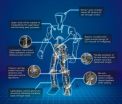(Press-News.org) Sometimes the fastest pathway from point A to point B is not a straight line: for example, if you're underwater and contending with strong and shifting currents. But figuring out the best route in such settings is a monumentally complex problem — especially if you're trying to do it not just for one underwater vehicle, but for a swarm of them moving all at once toward separate destinations.
But that's just what a team of engineers at MIT has figured out how to do, in research results to be presented in May at the annual IEEE International Conference on Robotics and Automation. The team, led by Pierre Lermusiaux, the Doherty Associate Professor in Ocean Utilization, developed a mathematical procedure that can optimize path planning for automated underwater vehicles (AUVs), even in regions with complex shorelines and strong shifting currents. The system can provide paths optimized either for the shortest travel time or for the minimum use of energy, or to maximize the collection of data that is considered most important.
Collections of propelled AUVs and gliding AUVs (also called gliders) are now often used for mapping and oceanographic research, for military reconnaissance and harbor protection, or for deep-sea oil-well maintenance and emergency response. So far, fleets of up to 20 such AUVs have been deployed, but in the coming years far larger fleets could come into service, Lermusiaux says, making the computational task of planning optimal paths much more complex.
He adds that earlier attempts to find optimal paths for underwater vehicles were either imprecise, unable to cope with changing currents and complex topography, or required so much computational power that they couldn't be applied to real-time control of swarms of robotic vehicles.
While researchers have studied such systems for many years, "what was missing were the methodology and algorithm," he says — the mathematics allowing a computer to solve such path-planning riddles rigorously but quickly enough to be useful in real-world deployments. "Because ocean environments are so complex," he says, "what was missing was the integration of ocean prediction, ocean estimation, control and optimization" for planning paths for multiple vehicles in a constantly changing situation. That's what MIT's Multidisciplinary Simulation, Estimation, and Assimilation Systems (MSEAS) group, led by Lermusiaux, has now developed.
The team's simulations have successfully tested the new algorithms in models of very complex environments — including an area of the Philippines amid thousands of islands with convoluted shorelines, shallows and multiple shifting currents. They simulated a virtual fleet of 1,000 AUVs, deployed from one or more ships and seeking different targets. Adding to the complication, the system they devised can even account for "forbidden" zones that the craft must avoid and fixed obstacles that affect both the underwater craft and the flow of the currents, and even moving obstacles, such as passing ships.
Taking advantage of the "free ride" offered by the currents, the craft often follow startlingly indirect pathways, meandering around in loops and whorls that sometimes resemble a random walk. That's because it can be much quicker to drift with a current and then double back than to try to cut straight across, fighting the flow the whole time. In other cases, the AUV may find a quicker or more energy-efficient path by rising over, or diving under, jets, currents, eddies or other ocean features. Uncertainties in ocean predictions — and how they affect the optimal paths — can also be accounted for.
In addition to finding paths that are quickest or most efficient, the system allows swarms of data-collection vehicles to collect the most useful data in the fastest time, Lermusiaux says. These data-optimizing approaches could be useful for monitoring fisheries or for biological or environmental studies — such as a new National Science Foundation effort to characterize the New England Shelf Break, an area important to the region's fisheries as well as for climate research.
While the methodology and algorithms were developed for an underwater environment, Lermusiaux explains that similar computational systems could be used to guide automated vehicles through any kind of obstacles and flows — such as aerial vehicles coping with winds and mountains. Such systems could even potentially help miniature medical robots navigate through the circulatory system, he says.
The algorithm allows for real-time control and adjustments — such as to track a plume of pollution to its source, or to determine how it is spreading. The system can also incorporate obstacle-avoidance functions to protect the AUVs.
INFORMATION:
The team included mechanical engineering graduate students Tapovan Lolla and Mattheus Ueckermann SM '09, Konuralp Yigit SM '11, and research scientists Patrick Haley and Wayne Leslie. The work was funded by the Office of Naval Research and by the MIT Sea Grant College Program.
END
Feeling angry and annoyed with others is a daily part of life, but most people don't act on these impulses. What keeps us from punching line-cutters or murdering conniving co-workers? Self-control. A new review article in Current Directions in Psychological Science, a journal of the Association for Psychological Science, examines the psychological research and finds that it's possible to deplete self-control—or to strengthen it by practice.
Criminologists and sociologists have long believed that people commit violent crimes when an opportunity arises and they're low on ...
COLUMBIA, Mo. –Veterans are almost twice as likely as the general public to have chronic illnesses, such as diabetes and heart failure. Therefore, veterans may require more assistance from informal caregivers, especially as outpatient treatment becomes more common. A University of Missouri researcher evaluated strain and satisfaction among informal caregivers of veterans with chronic illnesses. The findings show that more than one third of veterans' caregivers report high levels of strain as a result of taking care of their relatives; yet, on average, caregivers also report ...
COLUMBIA, Mo. – Though women are better represented in the workforce and in higher education institutions, they still face barriers in employment, education and health care access and are more likely to live in poverty. Now, a University of Missouri expert says new research highlighting current issues affecting Missouri women provides insights that could significantly improve the lives of women throughout the state.
Kristin Metcalf-Wilson, an assistant teaching professor in the MU Sinclair School of Nursing, helped compile the Missouri Women's Report. The report includes ...
The 2011 Tohoku tsunami was Japan's deadliest in more than 100 years. Despite an extraordinary level of preparedness by the Japanese, the tsunami caused more than 90 percent of the almost 20,000 fatalities last March.
Georgia Tech Associate Professor Hermann Fritz and his research team are studying the impact of the tsunami on the Sanriku coast.
Using eyewitness video and terrestrial laser scanners from atop the highest buildings that survived the tsunami, Fritz has mapped the tsunami's height and flood zone to learn more about the flow of the devastating currents.
Fritz's ...
In both war and peacetime scenarios, fire in the shipboard environment is serious and frequently results in excessive damage and high repair costs because the fire is not detected or controlled adequately. To help further improve future shipboard firefighting capability scientists at the Naval Research Laboratory have formed an interdisciplinary team to develop a humanoid robot that could fight fires on the next generation of combatants. A humanoid-type robot was chosen because it was deemed best suited to operate within the confines of an environment that was deigned ...
Perspective Magazine announces that Holiday Systems International (HSI) has renewed its sponsorship package for the Third Annual Global Networking Expo, GNEX 2013 - The Global Meeting Of Minds. The agreement will provide HSI with exclusive sponsorship of the Perspective Magazine Awards Program and Platinum-level sponsorship for the event, to be held at the world famous Beverly Wilshire - A Four Seasons Hotel on February 4-6, 2013.
"GNEX is in touch with the industry and continues to demonstrate their Expo is valuable to the attendees," said Craig Morganson, ...
Pitney Bowes today announced it is expanding the availability of its Reliant Sorting Solution to the European Market, where its small-footprint design and robust capabilities will help small private posts provide fast, accurate and flexible services to their customers. The Reliant can also meet the needs of in-house and interoffice sorting applications. The Reliant sorter will be shown to European audiences for the first time at Drupa 2012 - Hall 4, Stand C04.
The Reliant Sorter will bring automation and full-integrity to three core market segments - incoming mail, outgoing ...
Rockville, Md. – – Wii remotes are not all about fun and games. Scientists can use them to assess and diagnose children with an abnormal head position caused by eye diseases. As described in a recent Investigative Ophthalmology & Visual Science article, researchers developed a low-cost digital head posture measuring device with Nintendo Wiimotes to help diagnose this condition, medically called ocular torticollis.
"Torticollis occurs in about 1.3% of children," said author, Jeong-Min Hwang, MD, of Seoul National University College of Medicine. "Accurate measurement of ...
RIVERSIDE, Calif. – A team of paleontologists has discovered the oldest animal with a skeleton. Called Coronacollina acula, the organism is between 560 million and 550 million years old, which places it in the Ediacaran period, before the explosion of life and diversification of organisms took place on Earth in the Cambrian.
The finding provides insight into the evolution of life – particularly, early life – on the planet, why animals go extinct, and how organisms respond to environmental changes. The discovery also can help scientists recognize life elsewhere in the ...
Just on the heels of both David Bowie and Freddie Mercury there was Jobriath, the first American folk and glam rock musician to declare himself openly gay in the early 1970's. Self proclaimed as "The True Fairy Of Rock n Roll", Jobriath's story caught the attention of Director/Producer Kieran Turner, who devoted more than two years of his time to produce a documentary that shows how the legacy of this multi-talented musician goes beyond the labels that were hung upon him. Ahead of his time, Jobriath was a pioneer in the very early days of glam rock.
For the ...

